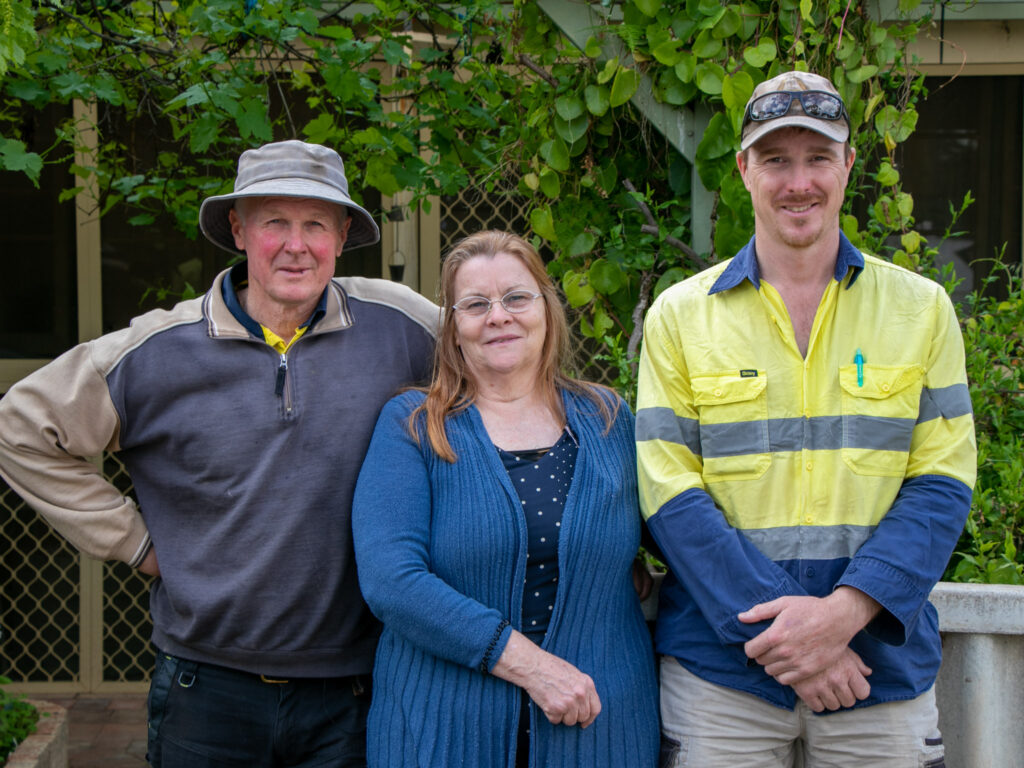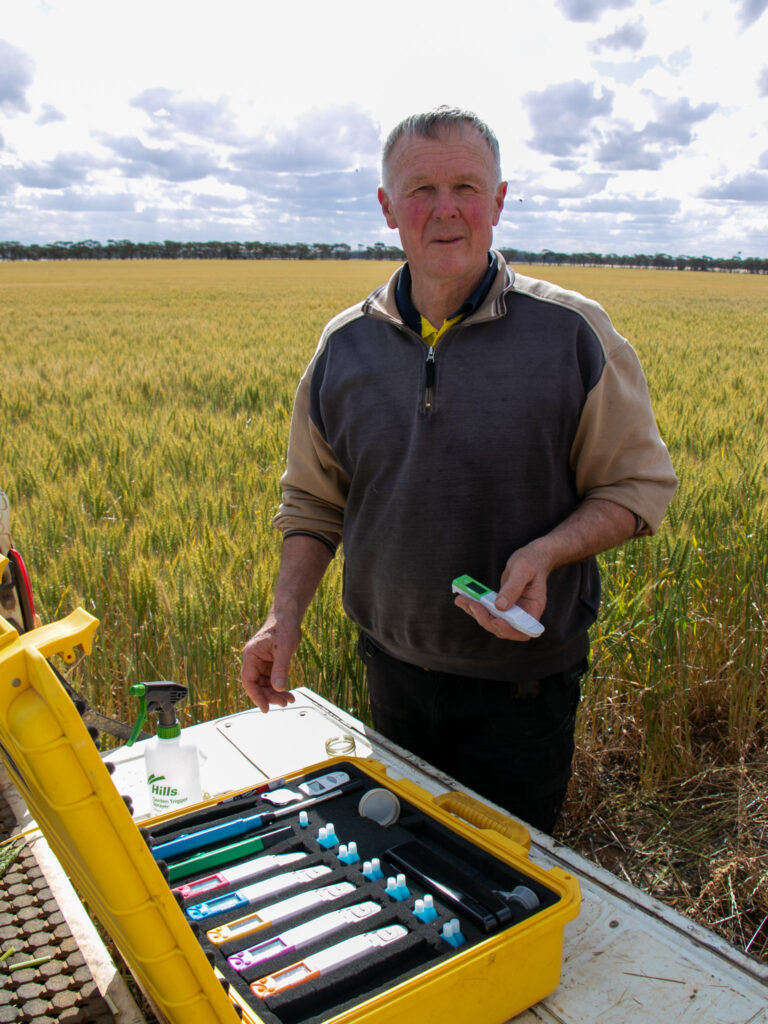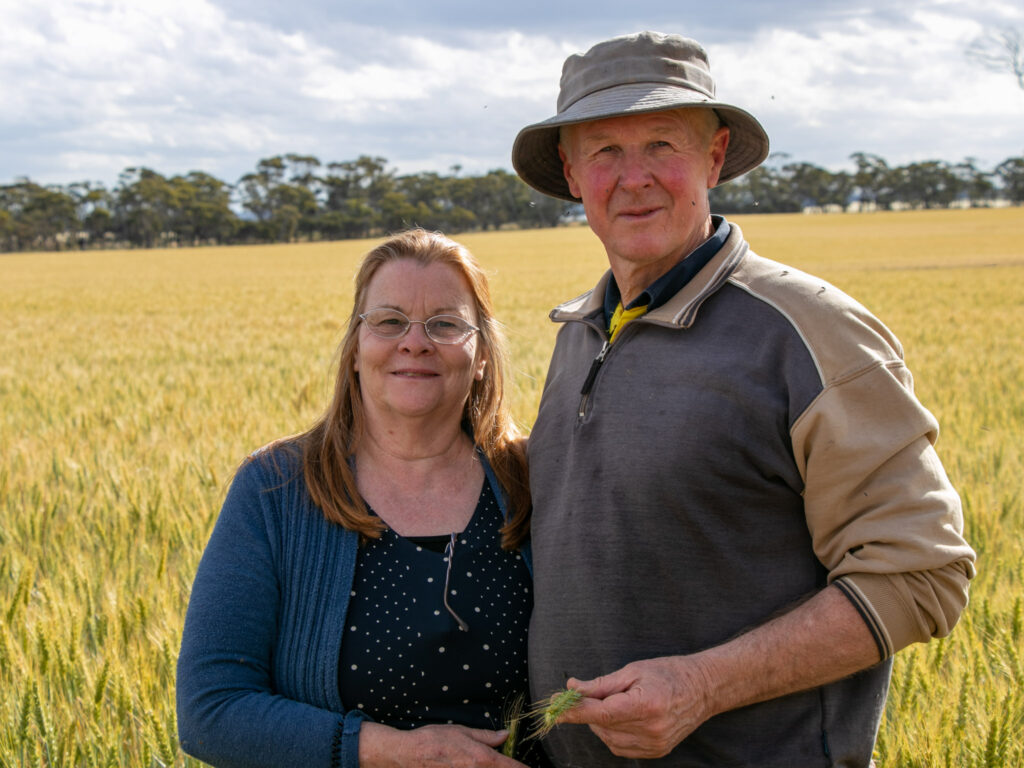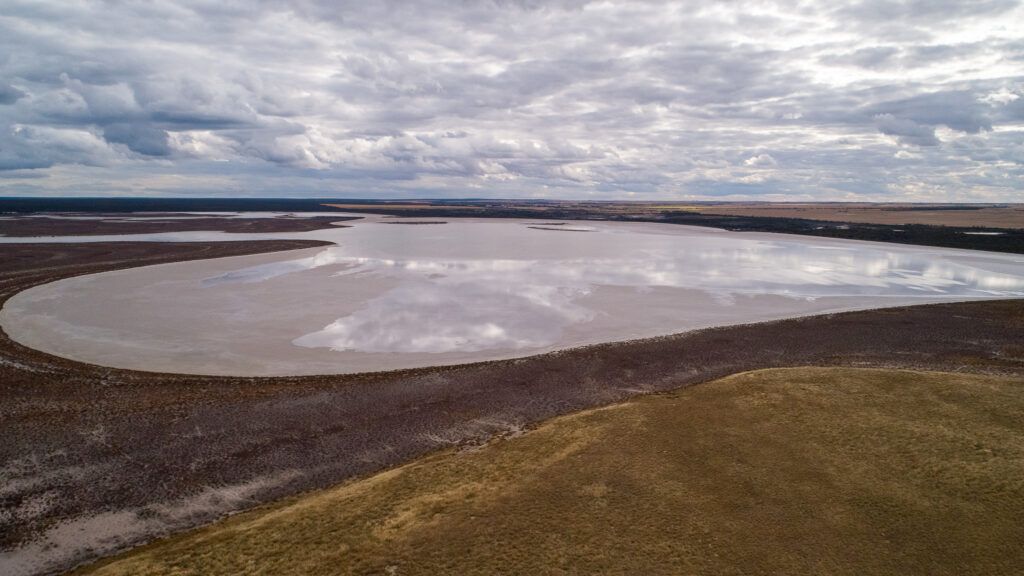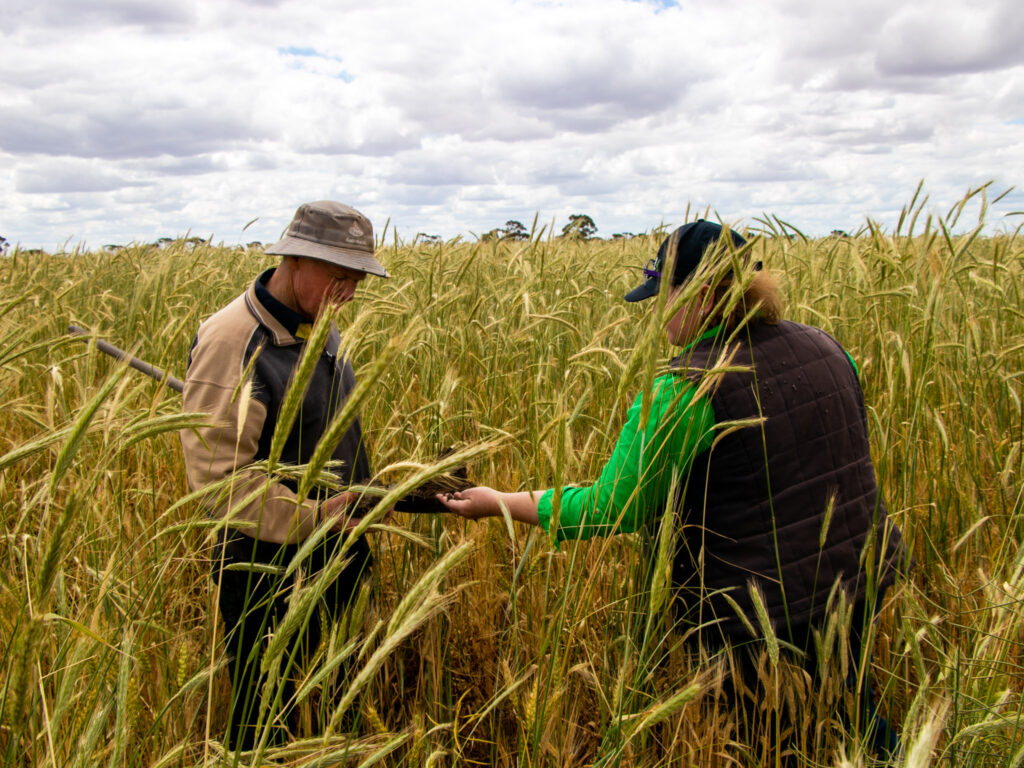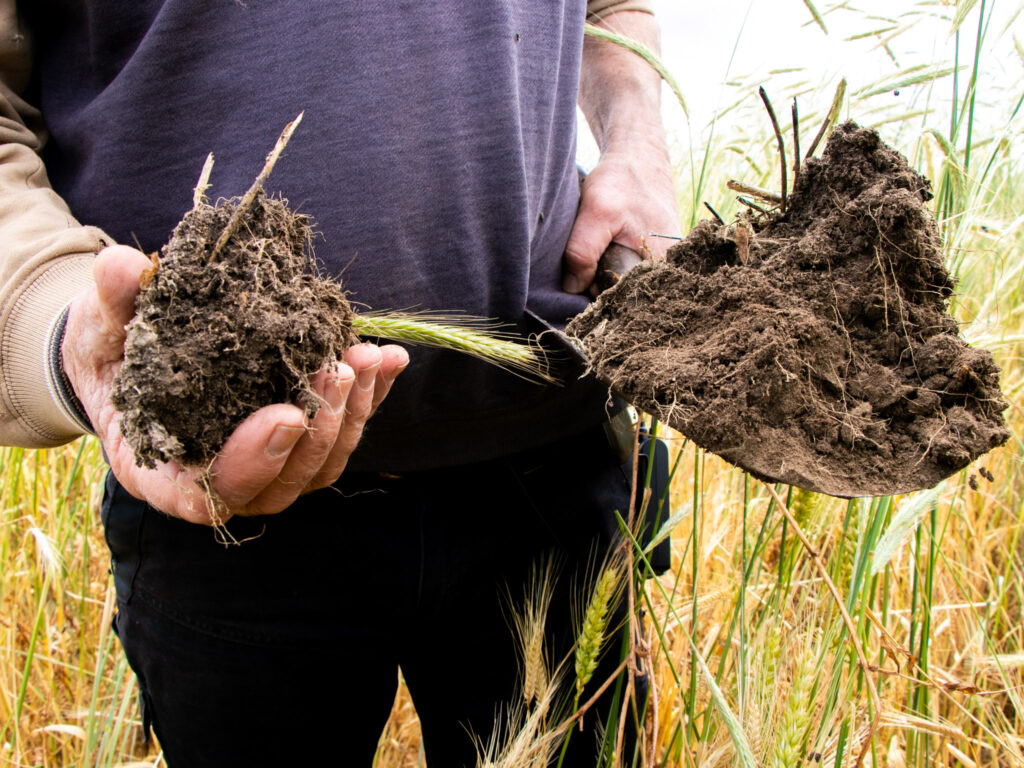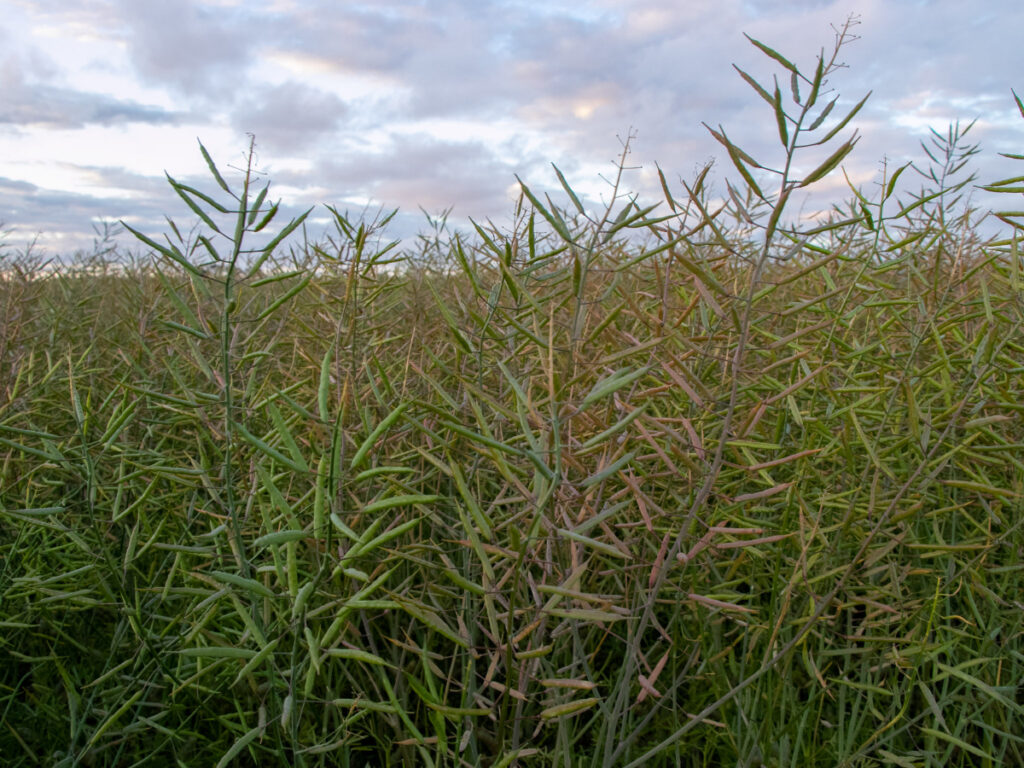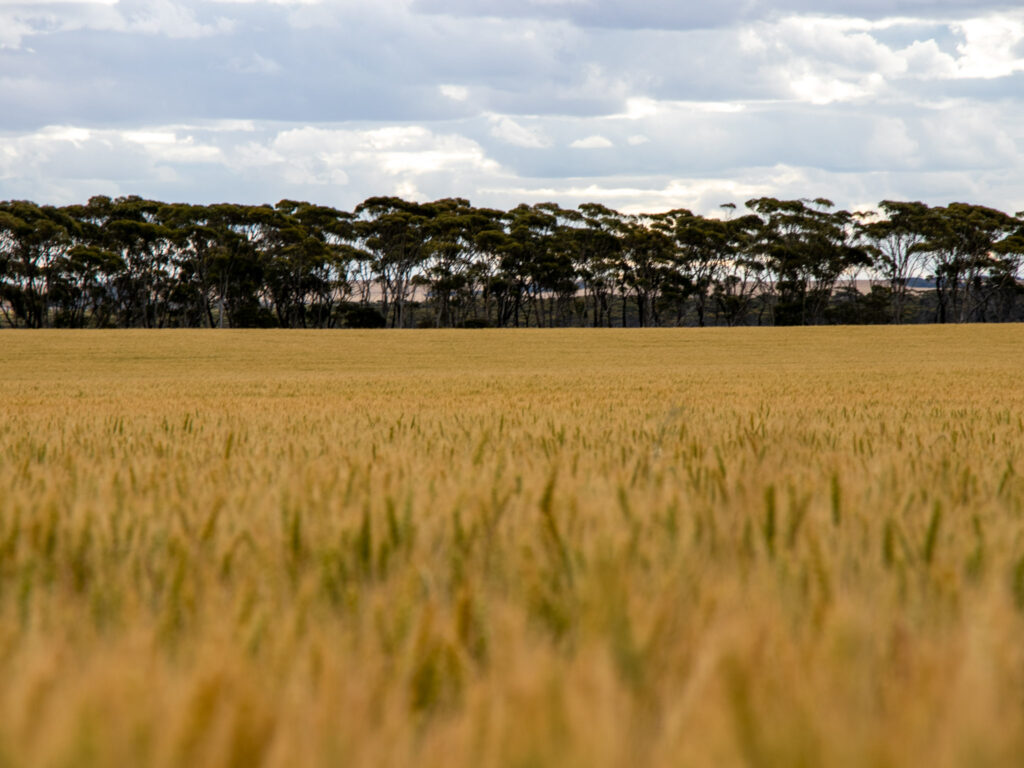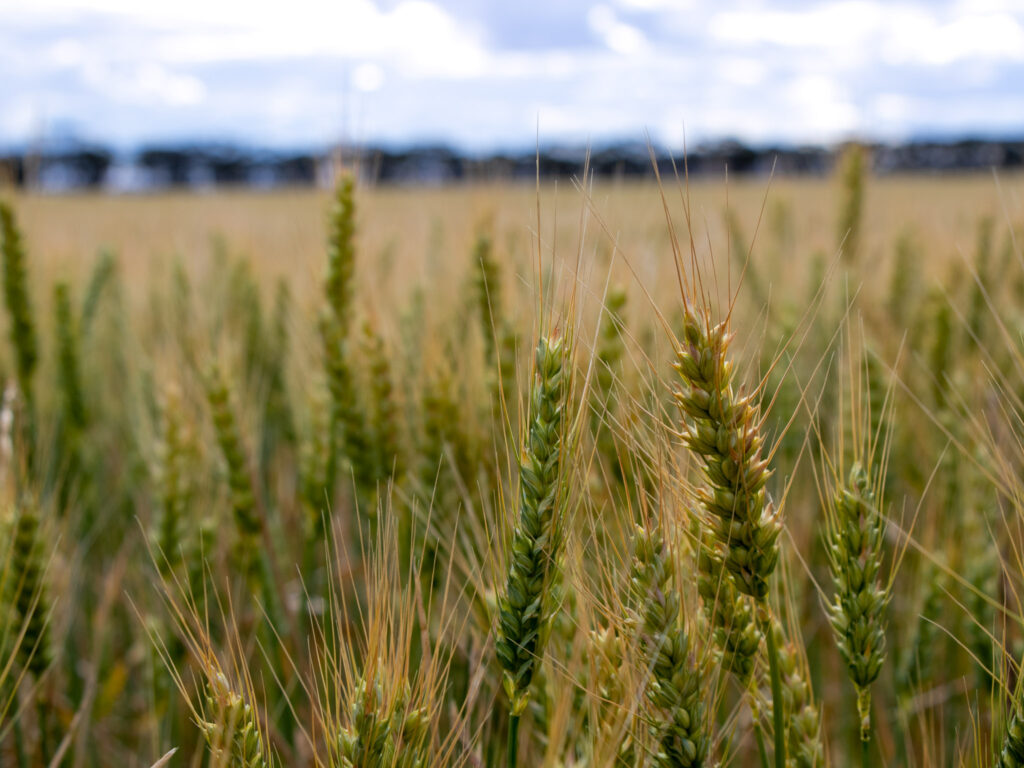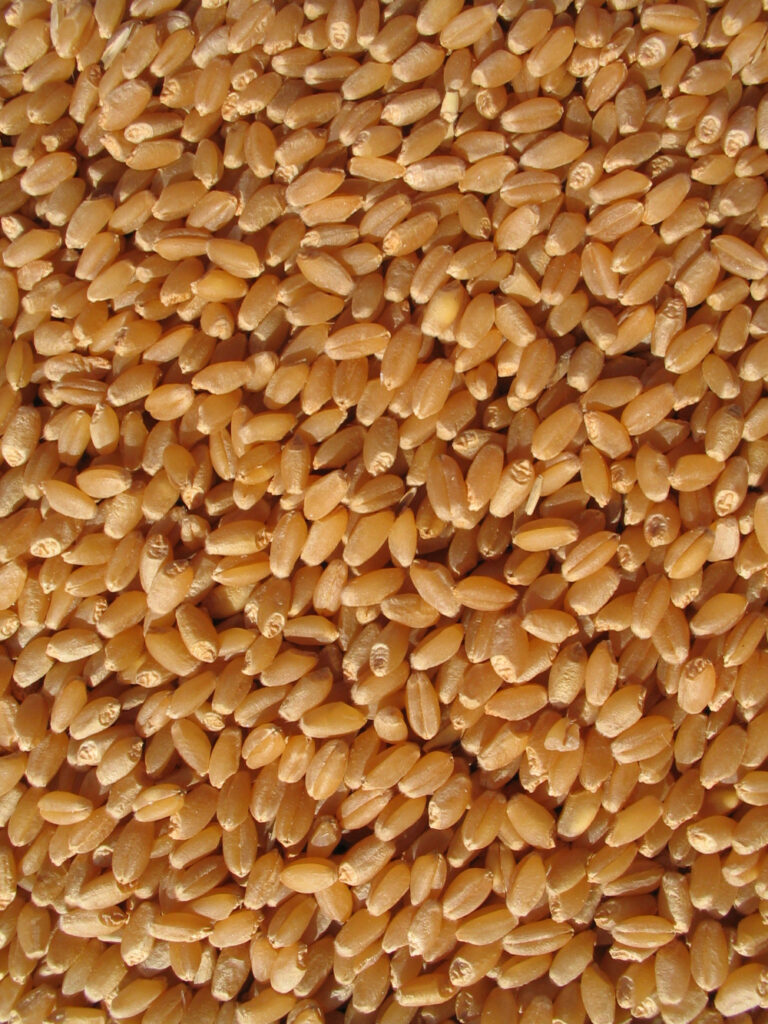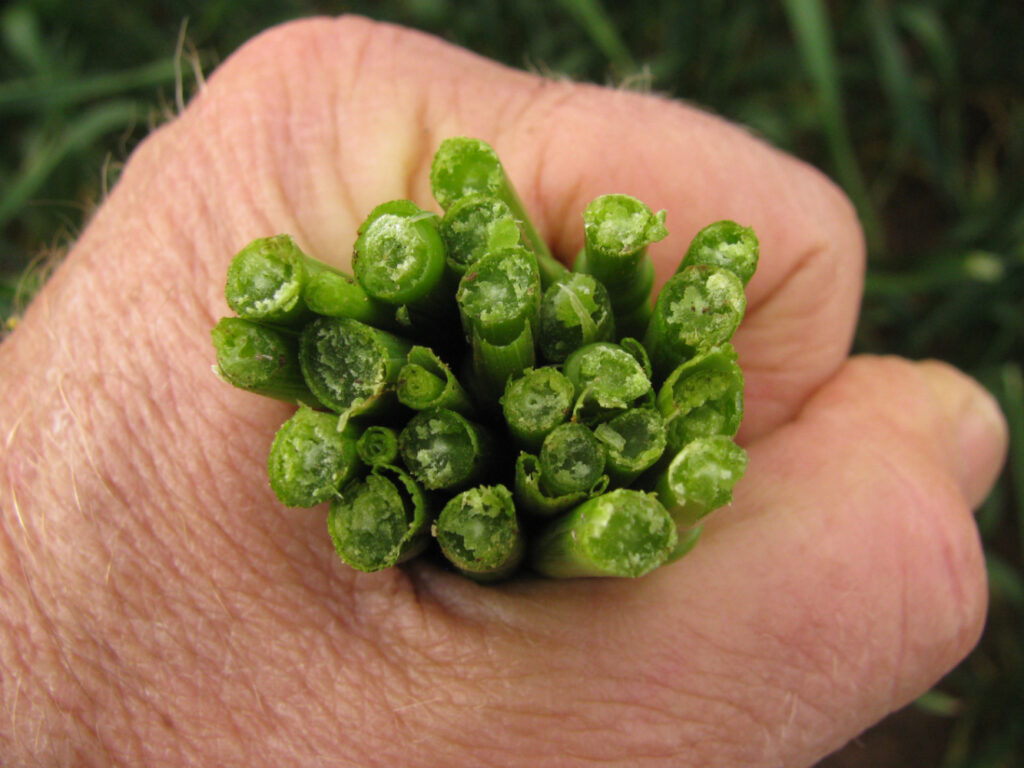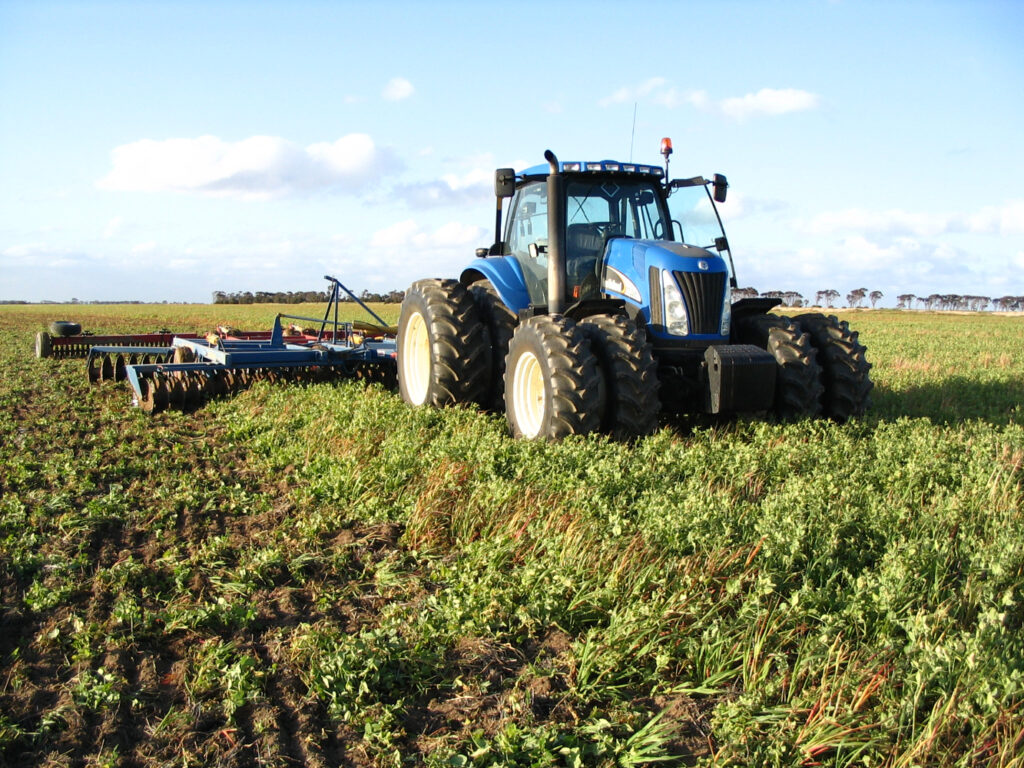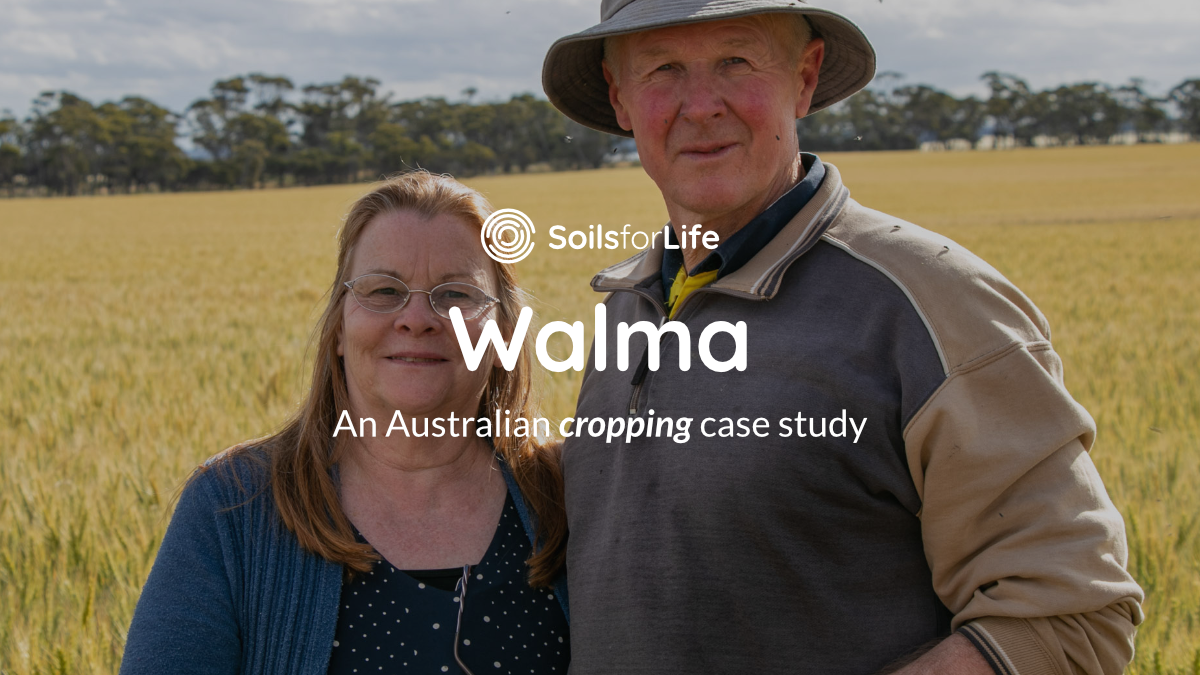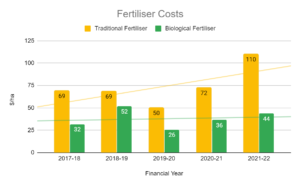The Hetheringtons at Walma
An Australian CROPPING CASE STUDY | Updated August 2023
Guided by the principle, ‘You can’t manage what you don’t measure’, Rob Hetherington took his first soil sample in the 1980s, when he began managing the family farm in the Lakes district of the south-eastern wheatbelt, Western Australia. Since then, Rob has collected hundreds of samples, which help him achieve his goal of farming ‘deeper’ to improve the health of the soil and plants, rather than expanding.
Surrounded by salt lakes, some of the area is high in sodium. Other areas were typically known as “Sunday Country” to describe the accelerated drying effect observed in these soils, where higher magnesium has caused the clay particles to disperse (‘Saturday it’s too wet, Sunday it’s just right, and Monday it’s too hard’).
Since the 1980s, Rob has been tweaking practices on the farm. He says observing that the farm system could be doing better is, ‘probably what’s driven me more to keep looking and seeking and asking’. But, it was also the health of Judi and their children that was a real trigger for Rob to begin his life-long interest in soil health and its relationship to plant nutrition and human health.
After learning from leading thinkers such as Dr Arden Anderson and Neal Kinsey, and visiting an Amish farm in America, Rob began work to improve the soil. His learning also led him to understand calcium as a pivotal element.
His approach was to change the chemistry first, which would then provide the right conditions for the biology to function.
Rob now sees signs of a more resilient landscape, with improved aeration, root growth, earthworm density, soil depth, and water infiltration. His crops are more even, and he is pleased with the softness, colour and even smell of the soil. In some areas, organic matter has doubled.
Some walked off the land, but Rob’s father stayed on. The Hetheringtons have faced the decision about whether to stay or leave several more times over their 40 plus years on the farm, but they have persisted. ‘It’s in Rob’s DNA’, says Judi. And Rob has a mission to improve the health of the soil and nutrition of the crops, a mission which has recently seen him named 2022 Wheatbelt NRM Soil Health Champion.
Farm Facts
Location
Nyaki-Nyaki Country | Lake King, WA
Average Annual Rainfall
333 mm (Lake King, 1993-2022)
Agro-ecological Region
Mediterranean
Climate
Warm summer, cold winter
Property Size
2,500 ha (Block Property 1700 ha; Home Property 800 ha)
Elevation
50 m
Social Structure
Owner and operators. Family run, with two generations working on the farm
Enterprise Type
Cropping of summer and winter grains, oil seeds, and legumes (multispecies, companion, and single species)
Growing Region
Eastern Wheatbelt, Western Region (Esperance Port Zone sub-region)
Landscape
Undulating and partially dissected landscape dominated by granite, greenstone, alluvial sediments, dunes and salt lakes. Lower to upper slopes, broad crests and upland plains (Block). Low level erosion plain, chains of salt lakes and associated lunettes (Home).
Soils*
Minor occurrences of Sodosols1The Australian Soil Classification (Isbell and NCST, 2021), including the Morell and Lake Bank soils. Loam or sand over clay, known as Grey mallee clays, and minor occurrences of gravel, sandy gravel and sandy soils with high levels of iron and aluminium.
*Learn more about soil classifications at Soil Science Australia
The Highlights
Practices and Innovations
Helpful Strategies
Indicators of Progress
- Applying mixtures of calcium rich nutritional amendments across the farm
- Using liquid bio-stimulants across the farm (e.g. liquid injects, seed dressings, foliar sprays)
- Applying green and brown manures
- Building ‘WISALT’ contour banks
- Diversifying crops to include multispecies and companion, including legumes to build nitrogen
- Making cropping decisions based on soil health and plant nutrition
- Ongoing monitoring of soils and plant nutrients – ‘You can’t manage what you don’t measure.’
- Being around ‘people who have been there and done that’
- Reading books, listening to podcasts, attending workshops, visiting farms
- Attending local farming workshops
- Creating a family decision-making plan
- Positive outcomes in multispecies and companion paddocks with reduced synthetic nitrogen, above average soil respiration, and a more functional microbial community when compared to other sites
- Observable signs of improved soil (aeration, root growth, earthworm density, soil depth and water infiltration rates) and crop health (fewer patches in crops)
- High sodium and magnesium soils responding well to calcium ameliorations
- 10% higher oil content (53%) in canola (lupin companion crop) than Western Australia base content (42%)
- New market for multispecies crop as feed for dairy producer, which has noted an increase of grain lipid content, increased quantity without compromising quality, and reduced mastitis in cows
- Efficient and limited use of herbicides, and barely any use of insecticides and fungicides, and focus on biological fertilisers, offering partial insulation from input price fluctuations
Cropping landscape and soils
About the landscape
Walma is located on the eastern side of what is known as the ‘Lakes District’ in southwest WA, which is part of the mallee zone. The landscape is described as ”subdued”, however, it is dominated by extensive salt lake chains, which formed from the infilling of valleys with salts and clays.
Due to the low rainfall and low gradient of the river, channel, and lake systems in the region, flows only occur after extreme rainfall events. The salt remains in the landscape because there is insufficient rainfall to flush it into the rivers or groundwater. Consequently, the soils in the district are both saline and sodic (Sawkins, 2011).

Figure 1. Satellite image of Walma Home and Block properties. Inset map: location of property within WA. Source: Soils for Life.
Lake King experiences a Mediterranean climate with relatively mild temperatures ranging from an average maximum of about 23°C, to an average minimum of about 10°C. The recent average (1993-2022) rainfall for the district is 333 mm, with approximately a third falling during the winter months. The district receives about 60 mm of rainfall (on average) during summer. Although rainfall is a limiting factor, agriculture in the region is rainfed and Rob will access dam water when necessary, and providing it is available.
In general, there is a close relationship between soil types and native vegetation across Western Australia. Both the soils and the associated vegetation often vary over short distances, resulting in complex patterns across the landscape (Sawkins, 2011). Mallee scrub occurs across the district and varies in its shrub understorey, reflecting the variability in soil types, and the texture-contrast and heavier textured soils support eucalypts.
There is also an intimate relationship between plants, microorganisms and soil formation. For example, the roots of the mallee redistributing water to out-compete understorey species, and the role of plants (e.g., Proteaceae) and bacteria in the formation of laterite soils. Native vegetation tends to be similar on colluvial and aeolian pale sands, as these soils have similarly poor water-holding capacity (Sawkins, 2011).
About the soils
Block property may be dominated by the Newdegate land system consisting of mainly grey and yellow/brown sandy texture-contrast soils, which are often alkaline and hardsetting, and texture-contrast sandy gravels. The minor occurrence of the Hope South land system is documented by Sawkins (2011) as representing alluvial deposits, red and brown calcareous loamy earths, and yellow and grey sandy texture-contrast soils which are also often alkaline (Figure 2). However, Rob has noted the absence of calcareous soils on both properties, which may indicate that some of the soils of these land systems either do not occur on his properties, or that the characteristics defining these soils occur deeper in the soil.
The Home property features the salt lake soils, saline clays and loams, and potentially the Lillian land system with calcareous loamy earths, and alkaline sandy texture-contrast, and the heavy-textured clay soils (including crabhole gilgai) associated with the extensive salt lake systems of the Lagan land system (Figure 2).

Figure 2. Satellite image of the land systems of the Lake King district in relation to Walma’s ‘Home’ and ‘Block’ properties. The land systems shown are: Hope South (calcareous loamy earths and yellow and grey sandy texture-contrast alluvials); Newdegate (sandy, texture-contrast soils and gravels); Lagan (salt lake and saline soils and calcareous earths); and Lillian (heavy clay soils, texture-contrast gravelly soils and calcareous earths). Source: Soils for Life. Note: The land systems represent a regional overview and are not derived from detailed soil information.
Elsewhere, grey and pale yellow sands occur near the salt lakes in the west and south of the district and localised pale sands occur on the lower slopes below sandy gravel or granite rises (Sawkins, 2011).
The Hetherington’s story
- Phase 1 - Catalyst for change
- Phase 2 - Building soil health
- Phase 3 - Millennium Drought
- Phase 4 - Expanding Crop Diversity
- Phase 5 - Now and Into the Future
Catalyst for change
1940 – 1990
Family farm and early enterprises
Rob grew up on the family farm located in the Lakes region of the South-eastern wheatbelt, Western Australia (see Figure 1 for property location). Rob’s father Wally, purchased the ‘Home’ property in the late 1940s and a nearby ‘Block’ in 1962. By then Wally had married Mary, and had a growing family.
Rob and his brothers, Bruce and Grant, helped Wally clear the new land of Salmon gum and mallee. Like many in the area, their enterprises were dictated by the market and what the Agriculture Department made available. They grazed sheep for wool and cropped wheat, barley and some oats. The standard rotation was two years of pasture for sheep and one year of crop.
In 1973 at the age of sixteen, Rob joined his father full time. Rob didn’t have a particular interest in farming, he wanted to join the army, but reflecting on growing vegetables as a young kid, he says ‘I suppose it was within me then to grow things.’
During this time, Rob’s father made the farming decisions. Not afraid to try something new, he was ‘pretty progressive for his time.’ ‘He was successful at what he did and worked with what he had around him… and was also good with getting the right time for things.’
A challenging landscape: Salt lakes and “Sunday Country”
Being near the salt lakes, much of the land on the ‘Home’ property is high in sodium. Excess sodium can cause structural changes to the soil which in turn compromise a plant’s ability to uptake water. High levels of sodium can also interfere with the uptake of other cations (positively charged atoms) – especially calcium, potassium or magnesium – resulting in poor plant growth. During the Great Depression in the 1930s soil assessments concluded that the area was unfit for farming. This ‘put the wind up’ some people who walked off the land. But Wally was one of those who ‘stuck it out’. He was advised by the agriculture department not to clear one area due to the salty soils, but he did anyway. And after the family learned to work with these soils (e.g. contour banks and then calcium applications and foliar sprays), they are now some of the farm’s best.
The ‘Block’ property has high magnesium levels. The challenges that come with farming this type of landscape were clear to Rob from early on. Rob recalls looking over land that he and his father had just cleared and ‘you could see the soil sort of shimmering after the rain.’ I thought, “Well we’re not putting that crop in this year,”.’ In fact, they called this “Sunday Country”, ‘Saturday it’s too wet, Sunday it’s just right, and Monday it’s too hard’, because of its high magnesium levels.
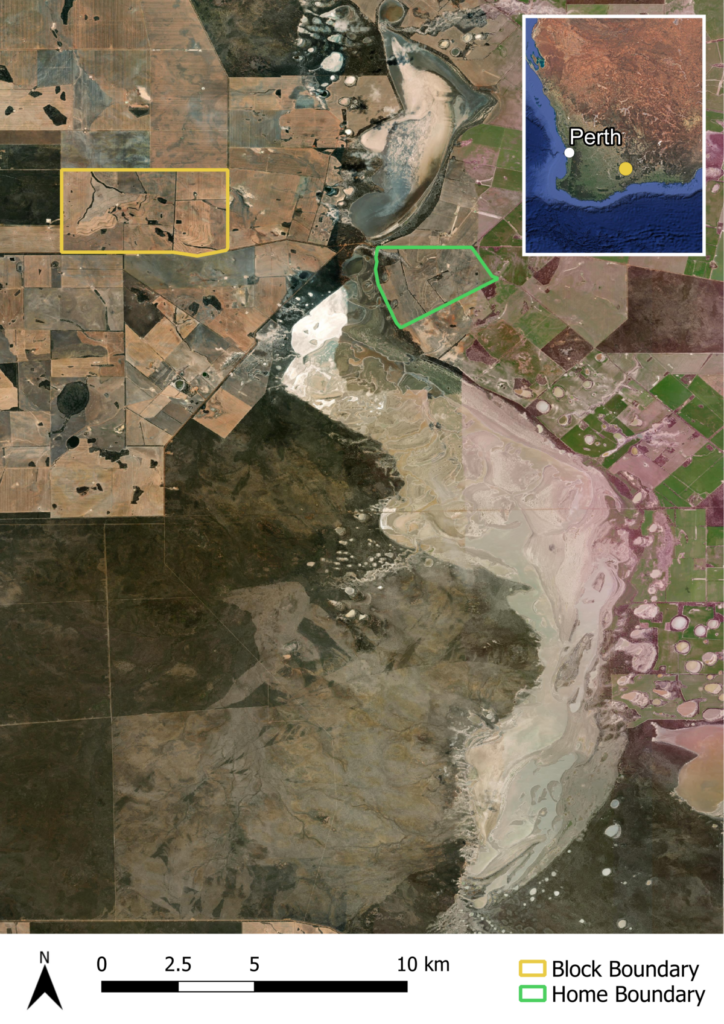
Figure 1. Satellite image of Walma Home and Block properties. Inset map: location of Walma property within Western Australia.
Early weed management
Prior to the 1970s and the introduction of chemicals, Wally’s approach to weeds was limited to grazing, or occasionally burning the weed seed.
When chemicals started to come onto the market in the 1970s, Rob recalls that the only available products were ester and a few herbicides. Glyphosate came in after that, and then availability and use of chemicals just expanded around them. Rob says, ‘I suppose that was just a done thing. You’re surrounded by it and that’s what you do’.
Succession and early practice change
Soon after marrying, Rob and Judi took over the management in 1983. Judi had grown up in Perth and trained and worked as a nurse. Rob’s parents moved off the farm, but during the 1980s his father helped out.
Rob continued with Wally’s farming patterns but began to try out a few different practices. At this time there was no major catalyst, Rob just observed that things could be better. But the increasing issue of salt, Rob reflects, ‘was part of what started me on this journey, because I used to look around here and I used to be grieved by the fact that it’s going salty.’ There was one area of particularly high sodium soils which had inconsistent yields and 50% patches through the crop.
In this period Rob was exposed to a wider variety of practices. He began trying a few new practices: running across the ground with harrows to germinate ryegrass, using rockdust to improve the nutritional profile of the soils and plants, and trialling lupins on the sandy soils to improve nitrogen levels. The rockdust resulted in more earthworms but it didn’t have the desired effect. Looking back he says the missing equation was calcium.
Practice highlight: Early soil monitoringIn this period, Rob began using simple soil tests. With his science way of thinking, it seemed like the logical thing to do. His motto was ‘why guess when you can measure’. Rob says, ‘I used to diligently go out there every year and take tests with a well known laboratory who did mainstream soil testing in WA and I’d get the results back and they’d probably say put on so many kilos of Agras fertiliser.’ Rob reflects that the tests were very basic and unhelpful and he acknowledges he didn’t have the knowledge and appreciation of soil that he does now. |
Slowing the water
The way water moved through the landscape was one of the first areas Rob worked on. The driveway would often flood, and there were areas of erosion which Rob believed were contributing to poor productivity. He looked at a range of management options before deciding to put in a type of contour bank called WISALT (Whittington Interceptor Self Affected Land Treatment Society). He took a course in a nearby town with local farmer and developer of the WISALT system, Harry Whittington.
Rob recalls how Whittington ‘worked out that the actual lateral flow of water going down to the lower landscape was causing a lot of his problems.’ Wittington then came up with a design that breaks the ‘landscape up with these huge big banks that stop the water from snowballing down the slope and give it a chance to soak in.’ The contours are ‘designed to spill over as an escape into the water course.’
Catalysts: chemicals, dust storms and a growing family
In addition to observations that things could be better, Rob often says that his soil health journey began because he, ‘got sick of having a sick wife.’ During the 1980s Rob and Judi started a family of four children, and Judi and the kids had ongoing health issues. Judi explains, she had respiratory problems and ‘our three children who were all born in the 80s all had chronic issues of their own…. Rob’s mum said there was none of that around when they were raising kids out here.’
During this time dust storms from cleared land and sheep were increasing. Judi recalls:
Very early on in our marriage, there’d be a dust storm. And the cottage lino was red. And the dust was so bad, you’d shut everything up, but the dust was so bad that when you walked on it, you left a footprint.
Chemical use on the farm and in the wider district and industry was also on the rise. An eye opening moment came when the neighbor across the road rang and asked whether Rob was out spraying. The neighbour then told Judi that she gets numb lips when Rob sprays. From this point on Rob and Judi became interested in human health, nutrition and the relationship to soil health and land management.
Building soil health
1990 - 2000
During this period, Rob expanded his knowledge of the relationship between chemistry and biology in soil health, and both Judi and Rob learnt more about human nutrition. For Rob, learning involved reading numerous books, surrounding himself with people who were also making practice changes, visiting farms and attending workshops.
Rob and Judi’s eldest son Daniel began working full time on the farm before heading to agriculture school.
Visiting the USA
Rob joined other Western Australian and eastern state farmers on a trip to the USA in the late 1990s, organised by biological agronomist Ken Bailey, to visit Neal Kinsey, Dr. Arden Anderson and Jeptha Gates and Amish farms in the Midwest. It was on the Amish farms that Rob learnt about improving soils through biological brews, observing how farmers would use their crop residues to make a biological brew that they sprayed back on the land. The soil responded well, it ‘was almost like you could eat it’, Rob recalls. During this time he was also introduced to Acres USA, a publication and community of farmers at the forefront of the biological farming movement.
These experiences led to Rob trying foliars, green manures and lime applications. He understood chemistry to be his primary limiting factor, and so he needed to have a strong focus on getting the chemistry right, which would then enable the biology to function.
Feeding the biology with foliars
Dr. Arden Anderson, a family physician and agricultural practitioner, came to Fremantle in the early 1990s and Rob attended his first soil school which highlighted the importance of feeding the biology along with the chemistry, since Arden was big on ‘feeding the biology’. It was after this workshop that Rob began to experiment with liquid injection and foliars.
At this stage, liquid fertilisers were uncommon in Australia, so Rob had to make a lot of his own. ‘We got a mixing tank and started making lots of different combinations of foliars and even setting up a mister.’ For example, they tried, ‘sugar and molasses and traces and tech grade MAP (Mono Ammonium Phosphate) and calcium nitrate mixed with dam water.’
Practice highlight: Calcium, ‘king of elements’A turning point for Rob was when he learnt about the important role of calcium in soil health through the knowledge of Dr. William Albrecht, a soil scientist who examined the relationship between soil fertility and human and animal health. Rob embraced the role of calcium as the ‘king of all elements’, responsible for: proper soil function and structure, drainage, oxygenation, strengthening cell walls of leaves, catalysing the functionality of other minerals, and feeding the biology. Rob began to look at farming challenges in new ways, drawing links between calcium and soil health. For example, through his own soil testing, he learnt that the pH level doesn’t necessarily indicate the level of calcium, as is often assumed. He also understood cutworm, which he had previously treated with insecticide, as a sign of calcium deficiency. And he understood that this also applies to the sour grasses, such as barley grass, silver grass, wild oats and brome grass. Rob began applying calcium to the whole farm and then concentrated on specific soils, such as alkaline ‘clay country’. He trialled a three way mix of gypsum, carbonate and hydroxide calcium plus rock phosphate. At the same time he would plough green manures – peas or oats or whatever grew – back into the soils, and he would only do this after he had applied calcium, with the aim being to build the calcium content, which also had the effect of increasing the carbon content because of the larger more prolific roots that were growing. |
Learning through trials and errors
It was not all smooth sailing in this period. Rob recalls having a huge crop after ploughing in a green manure, but it was followed by a wheat crop that started to rust and shrivel, and he went from fifteen bags per acre down to five. As Rob sees it, the reason would have been excess nitrogen from the green manure. ‘Excess nitrogen overrides potassium and copper uptake, which would have contributed to the crop shrivelling up. The crop had got rust in it because of the low copper and the excess sodium which would have taken over.’
Applying liquids with new combinations of ingredients through the machinery also proved to be a learning curve. Often the liquid inject would block up and cause delays. Rob recalls finding the cause one day after seeing the liquid tank cap lying on the ground. He figured out it had blown off after the combination of calcium with nitrate, carbohydrate with molasses, and dam water with silt had contributed to a build up of microbes; the resulting pressure had blown the cap off. The pressure build up was also causing the discs to block. Rob reflects, ‘We’ve had painstaking hours, painstaking everything, working with liquids. I mean, it’s no wonder I didn’t have a revolt at seeding time.’
After observing that summertime is when a third of their rain falls and when their weeds come up, they tried C4 plants like millets and forage sorghums as summer crops. There were mixed results, depending on the rainfall and moisture in soil. But as Rob and Judi’s son Daniel recalls, they learnt that – at least in their context – you can’t expect to get two crops in a year in a paddock due to moisture limitations.
Practice highlight: Evolving soil and plant monitoringRob continued soil testing but now with a greater understanding of soil health. He reflects that the issues in this period were all arising from the imbalances in the soils’ minerals and biology, and each one motivated him to ‘correct the land’ in better ways. He began to understand the importance of relating the tests back to field observations e.g. water infiltration, soil evenness. He began testing the crop for nutrients and minerals using the newly developed sap tests. Rob says his monitoring practices enabled him to determine what the crops were requiring and then circle back and re-monitor with the in-field sap tests to confirm the improvement of crop health. |
The farming system responds
Over the decade from 1990 – 2000, the farm system responded well. Rob and Judi both agree that throughout the 1990s life on the farm was pretty good. The soils were generally softer, had better aeration, infiltration, depth, and more earthworms; and, there was better root growth. The crops were good and so were the finances, with greater profitability and no debt.
Millennium Drought
2000 - 2010
By 2000, the Hetheringtons had gotten rid of the sheep and gone to 100% cropping. Increasingly, sheep were not fitting into their farming system, and wool prices were dropping because of the stockpile. This turned out to be a good move because drought soon followed.
This decade was hard on the Hetheringtons. Judi says, ‘it seemed last century was great, there was no debt and we had investment and the accountant would ring and say you need to spend some money.’ But with the turn of the century came some of the toughest drought years, huge family upheaval, the collapse of the Australian Wheat Board, the Global Financial Crisis (GFC) and the complexities and increased accountant costs arising from the introduction of the Goods and Services Tax (GST).
During this period, Rob says, his farm wasn’t a ‘shiny example’ and there probably weren’t improvements. What helped the Hetheringtons and others get through was getting the crop in early. Even so, he says, ‘The reality is, when soil is without moisture, when it’s dry soil, the biology doesn’t work, even if you are doing everything right from a chemical/biological standpoint, if you don’t get the rain, you won’t get the results.’
Adjusting to 100% cropping
Removing sheep from the farming system presented new challenges. The Hetheringtons had to adapt to farming without the benefits of animals on the land, such as an ‘inbuilt’ source of nitrogen. Rob found it hard. He recalls, ‘I didn’t understand what I was doing’, and in the first year of 100% cropping, despite doubling the area cropped, his profit was the same as the previous year. This was because he wasn’t putting on enough nitrogen and because the previous crop would just ‘consume it’. That is, when he ploughed in the stubble residue from the previous crop the microbes would tie up the nitrogen whilst their increased community worked on breaking down residues. The lack of moisture also contributed to the slow breakdown of the stubble.
When they first removed the sheep, Rob and Daniel applied industrial nitrogen but adjusted how they used it by adding a carbon source, they also developed their nitrogen strategies, via legumes, companion mix choices, green manures, and improving the biology function.
Changing family and farm dynamic
In 2001 Judi and the other children relocated to Albany to continue schooling for the children. Judi also took over the farm office work, and purchased a bookshop (in 2003) and cafe (in 2005). Moving to Albany ‘dramatically changed the family dynamic’, says Judi, and this is a common reality for many rural families. Daniel stayed and supported Rob full time on the farm, but as the drought progressed, he had to find work off-farm and Rob was by himself.
Tough Years
In 2008 Rob’s father passed away. Judi describes this period as a ‘horrendous time’, impacting family and finances. ‘The better part of that decade was negative years.’ The Hetheringtons lost money with the collapse of the Wheat Board. And in 2009 when it came to putting in a crop, ‘there was no money’. Judi emphasised, ‘I mean there was no money… we’d used up all our investments to keep going during the poor years.’ However, because of the GFC, companies had threatened to cease supply (of seeds, machinery etc.) unless farmers signed legal contracts. This meant the Hetheringtons were forced to borrow money. During 2009, family commitments took Rob and Judi overseas, and Daniel was on the farm alone. As Judi explains, Daniel did all the right things but the rain just didn’t come, and the crop was greatly reduced.
Off the farm, Judi got out of the cafe. While it had been doing well for a new business, the landlord had begun major works on the building and they ended up losing a lot of customers.
These years weighed heavily on Judi, who was juggling many tasks while supporting family. Judi recalls, ‘I literally lay on my face in the dust out here and I said “God, take anything away at all”. Didn’t care what it was. So I kind of spiraled into depression over the intervening years.’
(Many farmers struggle with mental health, and we know that mental health is being severely affected by natural disasters, rising input costs, falling commodity prices and an uncertain economic outlook, as Norco’s 2023 National Farmer Wellbeing Report shows. If you are suffering from feelings of depression or anxiety, you can seek support from Lifeline on 131114 or find a list of services at https://loom.ly/eqBqozw)
During these years many family farms were being sold, and the Hetheringtons were faced with a choice. Judi says if it were up to her they would have sold the farm and bought an organic farm down south, but while these were very tough years, she recognises that Rob had work to do and a vision (‘it’s in his DNA to be here’) and he had a vision to restore soil health. Rob acknowledges that it hasn’t been easy, but ‘every life has challenges but also ups and downs’, and perseverance, tenacity and fate helped him through.
Expanding Crop Diversity
2010 - 2022
Family decision-making and succession
As the drought period came to an end, the Hetheringtons worked together as a family to develop decision-making strategies. Judi says that the family ‘drew a line in the sand’ and decided:
We will not borrow above that amount, we will not have any more than that amount of machinery on the home property. We didn’t get any other land. We’ve made those kinds of decisions to manage our circumstances along the way.
It was during this period that Daniel and Kate got married and decided to live on the land and start a family. And after doing a succession planning workshop, Judi, Rob, Kate and Daniel began to have regular business meetings to work through big decisions. Judi also stepped back from doing the farm books. She had become very involved in the bookshop, and felt it was time for Daniel to learn the ropes and for Rob and Daniel to make all of the farm decisions.
With Daniel on the farm full time, Rob and Judi were able to step away. In 2015 they took a trip to Israel to look at agricultural practices in similar climates. The Australia-Israel Chamber of Commerce put together a program based on Rob’s interest, including water management practices. Rob and Judi visited a number of water and irrigation plants, and learnt about a practice of reusing water three times over. The trip to Israel confirmed to Rob that ‘in Australia we have a good handle on, and innovations in, the field of broadacre marginal farming.’
Multispecies and a dairy market
In 2015 Rob and Daniel began experimenting with multispecies cropping. Rob doesn’t recall why they decided to go down this path, ‘it just seemed like the natural thing to do’ as they had been companion planting since the 1990s. The first multispecies crop was a summer crop in 2015, including millets, cowpea, safflower, sunflowers and lablab. Initially they ploughed in one paddock as a green manure and harvested another (dominant in millet) and graded it to sell the seed to farmers. In 2021 a market became available to sell the multispecies crop as feed to a dairy. The dairy asked for more in 2022, prompting Rob to become ‘more serious’ about multispecies cropping. One of the benefits of the dairy market is that they have a cash crop which they can send, ungraded straight from the header.
In 2021, they put in a ‘seven way’ winter multispecies crop with a disc seeder, sowing wheat, barley, cereal rye, faba beans, lupins, vetch, and a bit of canola, totalling 80 kg/ha for 275 hectares. In 2022 they changed the recipe to include peas and increased the hectares.
Around the same time they bought a seed grader, which was long overdue as they had been companion planting for many years. They now use this to grade out companion crops, for example canola and lupins, and faba beans and canola.
Practice highlight: Routine soil and plant monitoringRob acknowledges he has a ‘bent for the tools’. Soil testing and plant testing is now a common part of his decision-making process. |
Now and Into the Future
2023 - ongoing
Family decisions and succession
The family is now at another crossroads. Judi says that the next step for her and Rob is semi-retirement. Judi would need to finish up with the bookshop and Rob would need to transition off the farm. Although, she says, ‘I think Rob’s always going to be connected to here.’
Daniel is grappling with where to go next with the farming system. He feels like the right thing to do is to farm for soil health and to continue many of the practices. But he also wonders whether they can keep it up and whether a ‘more conventional route’ may be more straightforward. Daniel offers a few thoughts for other farmers considering changing practices:
It’s like anything. You have to believe in what you’re doing, because a lot of what we have done has certainly been hard work or certainly complicates things. You have to know the reason as to why you’re doing it and believe in the reason.
For the moment, Rob and Daniel continue to feed the biology and build the function of their system, using a combination of calcium mixes, green manures, and biological stimulants based on feedback from soil and crop tests and observations. They continue to tweak the combinations and experiment with the best machinery and processes along the way.
Refining use of bio-stimulants
Rob likes to keep their bio-stimulant recipes and application ‘simple’ now, using fish and fulvic acid, and kelp as a standard liquid whenever they spray a paddock. For seed dressings he uses vermi juice and fish mixed in a portable spray tank and apply up through an auger. He has a company that makes a liquid for seeding time, including sulfate trace elements, as well as carbons, kelp, and fish, to which they add more kelp. Rob combines the bio-stimulants with other practices, such as calcium ameliorations. For example, recently in one paddock located near the salt lake Rob put on a soluble calcium, and ploughed it in with a green manure. He then planted a rotation of millet, barley and canola before a 2022 wheat crop. He applied Urea Ammonium Nitrate (UAN) with a liquid carbon, and trace elements at seeding time, and then a foliar spray of dissolved urea, fulvic acid, fish and kelp and amino acids, and commercial liquid biostimulant). For more detail on Rob’s use of bio-stimulants see this article2https://soilsforlife.org.au/bio-amendments-insights-from-cropping-farmers/.
Rob now recognises that much of the effectiveness of foliars is about timeliness.
I’m more aware of actually getting it on at the right time, putting the right thing on. Whereas in the past, we didn’t have that same awareness so we were just doing it because we felt it was the thing to do and the plant needed it. So you put it on but functionality probably might not have worked as good as what it could have.
Considered use of chemicals
The Hetheringtons don’t use more modern or complex chemicals, they only use them on an ‘as needed’ basis rather than as standard practice, and their use is far lower than industry and district standards. For example, unlike most conventional croppers, they don’t ‘croptop’ (apply a herbicide late in the season to prevent weed seeds). They have received encouragement from their dairy customer to continue their approach of minimising chemical use, because, according to the dairy, chemicals affect the milk. They have also worked out ways to use chemicals more efficiently, for example, they mix chemicals with biologicals for an ideal pH solution and better chemical efficacy while supporting the degradation of the chemical residues via biological activation. They also rarely use fungicides and insecticides because Rob believes these are the most damaging to biology.
Continued companion and MS cropping
Rob and Daniel continue to use companion cropping to supply nitrogen from non-synthetic sources, helping the nitrogen cycle. For example, this year one paddock included canola with lupins. They don’t need to add any nitrogen to the multispecies crop, which now makes up 30% of their enterprises, because legumes are included. Daniel admits that companion cropping does complicate their operation, as ‘you can’t just harvest it, and send it down the road. You’ve got to clean it and separate it’. For example, last year they separated the lupins and canola straight off the header. ‘The canola went onto the truck to town and the lupins went into a bag to then go to the dairy.’
Adjusting the WISALT banks
Now that soils across the property have better water infiltration, they no longer need all the WISALT banks. Daniel is keen to see some of these go as they get in the way when using large machinery. But they are taking it slowly, observing whether banks fill with water, and leaving those that do. And they are only removing every second bank to allow a greater gap between them.
Soil health champion
Over the past 30 years Rob has refined his farming philosophy to be one of farming ‘deeper’ rather than expanding. ‘Farming deeper’ includes doing all he can to take good care of his “underground livestock” – the biology, microbes, organisms. Rob reflects:
When you go out into the paddock and you do something, you’ve got to think “am I harming that livestock or am I putting something on to benefit them, so they can help me?”… That livestock is your underpaid work force that’s working for you all the time in the soil.
For his dedication to soil health, Rob has recently been awarded with the 2022 Wheatbelt NRM Soil Health Champion.
Indicators of progress
Key insights
Rob is realising his goal of improving soil health and crop nutrition in the face of a low rainfall climate and challenging soils.
With reduced synthetic nitrogen and an increase in quality and income, Rob has had positive outcomes with his companion and multispecies crops. In 2021 the oil content of his canola crop (grown in companion with a legume) was 51.3%, compared to the Western Australia base content of 42% (Kingwell 2019), achieving a premium price of $1100/tonne. And Rob’s ungraded multispecies crop is highly valued by his dairy customer for its impact on milk quantity and quality, and cow health. The dairy has recorded grain lipid content of 4.4% compared to 1.4% in 2021, and the dairy noted an increase in the quantity of milk without compromising protein and butterfat. They also noted an overall improvement in animal health indicated by lower somatic cell count leading to lower levels of mastitis. Rob has also observed that the overall plant growth (biomass) in the multispecies crop is very substantial.
Rob’s soils have come a long way. Across the farm, Rob reports that he has observed signs of improved soil aeration, root growth, earthworm density, soil depth, and water infiltration rates. Some of his most challenging soils (those with high sodium and high magnesium levels), are responding well to Rob’s management, with two of the focus sites showing a reduction in sodium to a depth of 10 cm. Rob attributes this in part to the addition of calcium.
There also appear to be below-ground benefits in the multispecies and companion paddocks. In the multispecies paddock Rob has noticed that the soil has softened up, and the top 10 cm of soil is well flocculated (soil that is aggregated, with improved aeration). These observations are supported by the soil test results. Both the multispecies and companion crop sites are Rob’s healthiest soils, with above average soil respiration and moderate microbial activity which positively influences nutrient cycling, the building of soil organic matter, and soil aggregation. The recent tests also show that Rob is progressing towards his goal of improving organic matter in his soils with one site almost doubling since 2012 (from 2.3% to 4.2%).
With a focus on using biological fertilisers, efficient use of herbicides, and very limited use of fungicides and insecticides, Rob is developing a resilient and efficient farming system. From 2017 to 2022 Rob’s biological fertiliser costs increased at a much lower rate than traditional fertilisers on a per hectare basis, offering partial insulation from global price fluctuations, such as the substantial increases in urea and phosphate prices during 2021 and 2022. The selective use of nitrogen fertilisers across the farm also insulates the business from these price fluctuations.
Rob and Judi have developed personal resilience in the face of many climatic and personal challenges, such as the trying period of the Millennium Drought. Their decision to work within a comfortable level of debt, as well as their progress towards soil and crop quality goals, have positively impacted both Rob and Judi’s wellbeing in recent years.
Approach to collecting indicators
Farms are complex social and agro-ecological systems, and each farmer has different goals, which means a different approach to monitoring is required for every farm. For Soils for Life case studies, we are guided by the case study farmer’s goals, and take a holistic view that includes an assessment of progress towards social/personal, ecological and financial outcomes. The information presented in this section is based on available data at the time of reporting, and may be influenced by seasonal or market conditions. This report should be read with this context in mind.
- Healthy and biologically active soil with good levels of organic matter
- Healthy crops, while working within the limitations to production (low-rainfall and soils with high sodium and magnesium levels)
- Efficient running of the farm at its existing scale, rather than increasing farm size
- A comfortable level of income for the family with a defined level of farm debt, minimising machinery investment
Although he has been monitoring soil and plant health on Walma for decades, Rob was keen to incorporate new methods into his soil monitoring regime, like the Haney tests for exploring the soil microbiome’s functionality. When Soils for Life visited Rob in October 2022, we identified six sites with him to explore in more detail (details below).
- Interviews and surveys with Rob
- Reviewing information and data compiled over the years by Rob
- Soil and landscape observations and soil sampling at six sites across the farm
- Soil chemical and biological testing of the soil samples in the laboratory.
Further details on these investigations are provided in the ‘Deeper insights’ sections below.
Deeper insights - Soil and landscape
Soil and landscape analysis method
Soil and landscape observations included:
- Above ground observations of vegetation and waterways
- Below ground observations of soil structure, colour, smell, plant roots, bacteria, and fungi.
In addition, soil samples were collected from 0-10 cm depth along a transect at five sites across the farm (see Figure 4 below). The samples were submitted for three complementary laboratory test suites, each of which provides a different perspective on the chemical and biological contents and condition of the soil. Each lab provides reference ranges against which the Young Seeds results can be compared:
- Agricultural Soil Analysis3Analysis undertaken by the Environmental Analysis Laboratory (EAL). Please refer to this EAL example of an Agricultural Soil Analysis Report for the EAL guidelines and ranges that SfL has used to guide interpretation in this report. – a suite of chemical tests to identify the available and total nutrient levels to support farm management.
- Haney Soil Health4Analysis undertaken by the Environmental Analysis Laboratory (EAL). Please refer to this EAL example of a Haney Soil Analysis Report for the guidelines and ranges that SfL has referred to in this report. – a suite of tests to indicate the size and functionality of the soil microbial community, including soil respiration, Water Extractable Organic Carbon (WEOC) as an energy source, and Water Extractable Organic Nitrogen (WEON) as a nutrition source.
- Soil Foodweb5 Analysis, guidelines and ranges provided by the Soil Foodweb Institute (SFI), which SfL has used to guide the interpretation in this report. – a snapshot in time of the types of microbial “workers” present in the soil.
The sites selected for soil sampling
Site 1 Home (MS): Two years of multispecies (MS) with 7-way mix (2021 wheat, barley, cereal rye, faba beans, lupins, vetch, and some canola; 2022 peas). No synthetic nitrogen and no foliar sprays.

Site 2 Home (MS – brome): Management as at Site 1 but different plant communities currently dominating (e.g. brome grass), and the soils often lack moisture.

Site 3 Home (High sodium): Proximity to salt lake. Managed with calcium over several years. Recent management: soluble calcium, green manure, rotation of millet, barley and canola before 2022 wheat crop; biological applications at seeding and foliar sprays.
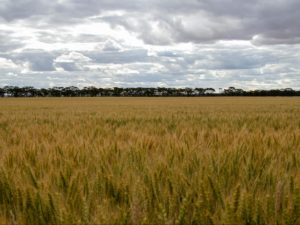
Site 4 Block (Calcium trial): Hard clay, problematic soil. Trial site (next to site 5). Calcium amendments prior to sowing wheat over multiple years. Commercial liquid biostimulant as a foliar spray.
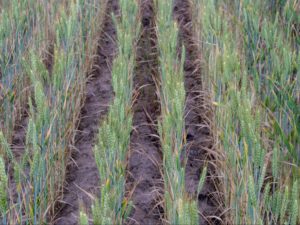
Site 5 Block (Calcium trial – control): Similar conditions/soils/management to site 4 but no calcium amendments applied.
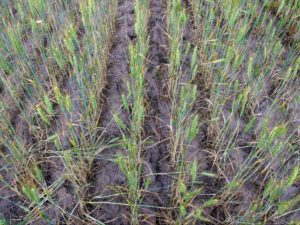
Site 6 Block (Companion): Gravel soil. Alternate rows of lupins and canola. Canola grown with reduced synthetic nitrogen. Application of MAP, guano fertiliser, foliar sprays, and liquid injects.
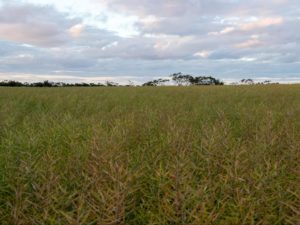

Figure 3. Satellite image of Walma property boundaries, with overlays of the land systems and the soil sampling sites selected by the Soils for Life team and Rob Hetherington in November 2022. Source: Soils for Life. Note: The land systems represent a regional overview and are not derived from detailed soil information. Rob has noted the absence of calcareous soils on both properties, which may indicate that some of the soils of these land systems either do not occur on his properties, or that the characteristics defining these soils occur deeper in the soil.
Interpretation of soil test results
Soil is one of the most complex ecosystems on the planet. The three laboratory test suites have been chosen to provide complementary perspectives on soil health, and contain a considerable amount of information on soil chemistry, biology and functionality. However, soil tests represent a fraction of the complexity of the soil system, at a single point in time – in this case, the samples were collected in October, when the temperatures were rising, and crops were a few weeks from harvest.
Importantly, the comparative averages, guidelines and ranges referred to in this report reflect those provided in the laboratory-generated reports and are not necessarily specific to the farming property, region, soil characteristics, history and management goals.
Snapshots of the results from these tests are shown in Figure 4 below, and the full results are provided in Appendices A, B and C. Note: Each row of results has been coloured using a grey scale, where the lightest colour is the lowest number and the darkest colour is the highest number in the row. Colour coding does NOT indicate positive or negative results, and is merely provided to allow simple visual comparison of the numbers in each row. The results need to be interpreted with care (repeated testing over time is necessary to produce reliable insights and trends).
Importantly, the comparative averages, guidelines and ranges referred to in this report reflect those provided in the laboratory-generated reports and are not necessarily specific to the farming property, region, soil characteristics, history and management goals.
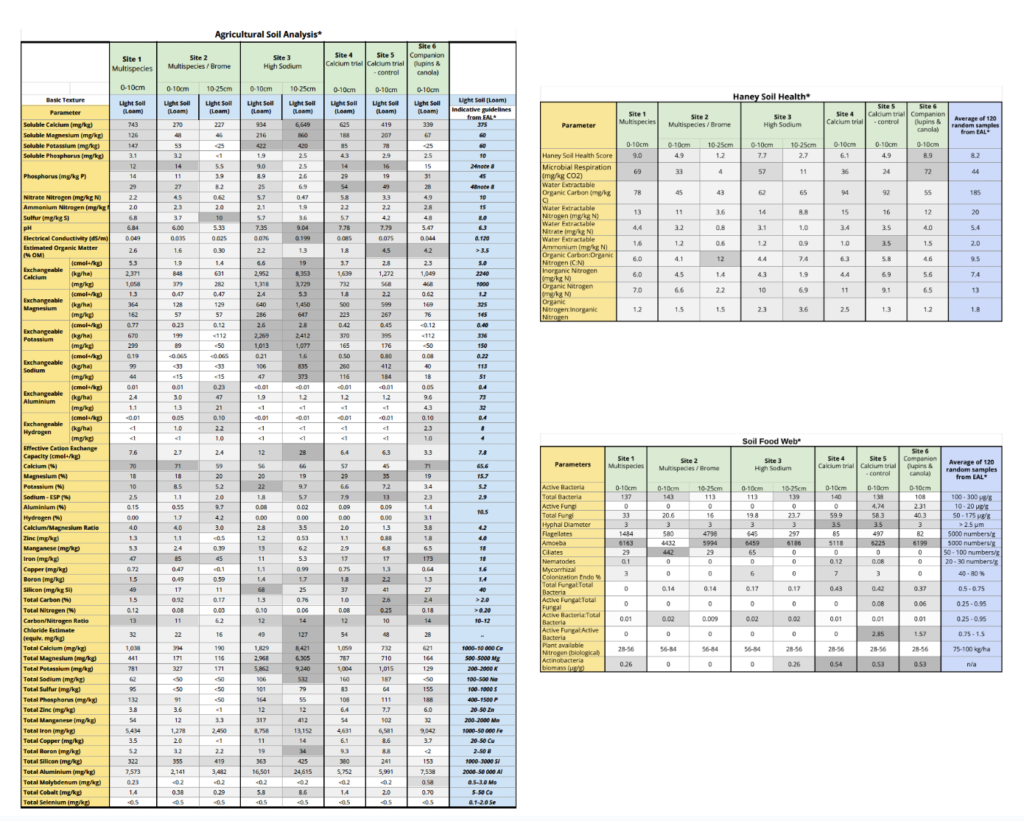
Figure 4. Snapshots of results from Walma soil tests. Source: EAL; Soil Foodweb Institute; Soils for Life. See Appendices A, B and C for full detail.
- Rob’s most challenging soils, with historically high sodium and high magnesium levels, seem to be responding well to his management, with two of the focus sites showing substantial reductions in sodium to a depth of 10 cm. Rob attributes this in part to the addition of calcium. Comparing the 2022 tests to those taken in 2015 (site 3) and between the trial sites (sites 4 and 5), there is a trend towards a decrease in sodium base saturation and an increase in calcium base saturation6Rob tested the soils at site 3, 4 and 5 in 2015 and then again with Soils for Life in 2022, all to a depth of 10 cm. The 2022 test results compared to the 2015 results showed at site 3: a decrease in sodium base saturation from 25% to 1.8%, and an increase in calcium base saturation from 27% to 56%; at site 4 compared to site 5: an increase in calcium base saturation from 45%- (site 5) to 57% (site 4) and a reduction in the base saturation sodium from 13% (site 5) and 7.9% (site 4)..
- Soils at the multispecies and companion crop sites show signs of improved soil health and have good microbial community, soil respiration and microbial activity7See Haney and Soil Foodweb Institute test results in Appendices B and C respectively..
- Soil organic matter was high at the companion site, having almost doubled compared to 2012 tests, suggesting the site may be responding to Rob’s management over the past decade8Please refer to EAL’s example of an Agricultural Soil Analysis Report for the EAL guidelines and ranges that SfL has referred to in this report. .
- The ratio of water soluble organic carbon to water soluble inorganic nitrogen across most sites is good, meaning these nutrients are more available to feed soil biology and then support healthy plants.
Available boron levels are ideal across Walma (except for site 2, see below), an achievement given that Australian soils are typically low in this micronutrient. These levels are significant for Rob considering his focus on calcium management and the role boron plays in supporting calcium function.
- While the combined test results show that the soil/plant system of many sites at Walma is working well to make nutrients and water available to plants, many of the micro and macro nutrient levels could be further balanced at some sites.
- While beneficial fungal species were found at all sites, the difference in fungal communities between the Block property (more fungi) and Home (less fungi) is worth exploring.
- Water extractable carbon to nitrogen ratios are below average according to the laboratory-derived ranges, which means that the microbes are ‘burning up’ more carbon than the current management is supplying.
- The soil tests at site 2 (MS brome) have confirmed Rob’s observations, showing less than ideal soil health indicators (cation exchange capacity, soil organic matter levels, levels of boron, levels of ciliates, compaction, low aeration). Together these conditions are having a compounding effect on the capacity of the microbiome and plants to obtain air, water and nutrients, which can limit the types of plants that will grow.
Landscape outcomes
Rob has observed many signs of a more resilient landscape at Walma in recent years. Along with observed and measured soil health outcomes, he has seen changes in the way water moves through the landscape. The WISALT contour banks were the first step in reducing water runoff, followed by improvements to soil water retention.
According to Rob, the contour banks have contributed to improved tree health. He recalls that the trees on Walma, as well as in other parts of the Wheatbelt, were showing signs of stress – putting out young shoots, which were being eaten by cockchafer beetles. Initially, Rob did not understand why there were so many beetles, and he tried to address the pests with a chemical spray. After the contour banks were constructed, the trees on Walma began to improve (unlike elsewhere in the district). Rob also noticed how an “ill patch” in the lawn disappeared.
Rob recorded the difference between the trees prior to the WISALTs and following their construction (Image 3 and 4), noting that the banks solved half of the problems on the farm but ‘You still have to actually get the water into the soil.’ That was the next step of the process (detailed in the soil inquiry above, and throughout the case study phases). Rob says that the combination of the contour banks and the improvements to soil water retention were evident in 2017 when they experienced a cyclone with heavy rain and his property ‘Handled it, whereas a lot of other places didn’t.’

Image 3: Tree with cockchafer beetles prior to WISALTs. Source: Rob Hetherington.

Image 4: Tree after WISALTs. Source: Rob Hetherington.
Deeper Insights - Farmer and farm
Personal and family
To explore farmers’ perception of change in their personal relationships over time, Soils for Life created a wellbeing survey of six themes with associated indicators (Table 1)9This wellbeing survey combines questions from four sources: the Regional Wellbeing Survey (University of Canberra); Vanguard Business Services ‘People Perspective’ survey; Regenerative pillars (For the Love of Soil, Nicole Masters); and the personal Wellbeing Index 11 (Australian Centre on Quality of Life, 2020). The Wellbeing Index 11 indicators – used by researchers (Schirmer, Yabsley, Mylek, & Peel, 2016) and in the long-term broadscale Regional Wellbeing Survey conducted by the University of Canberra (2020) – are considered important for holistically measuring the sustainability of farming systems (Brown et al., 2021). . Rob and Judi ranked each of these indicators, across all five phases, on a seven point scale from: very unhappy (1); unhappy (2); mostly dissatisfied (3); mixed (4); mostly satisfied (5); pleased (6); to very pleased (7). We then averaged the indicators to graph the ‘theme averages’ and observe their relative change over time, across the four phases (Figure 6). We also indicate below where any specific indicators are outliers in comparison to the general trend of other indicators in its theme.
Table 1. The six themes and indicators of personal relationships in the wellbeing survey.
| Relationships with: | Indicators |
| Self |
|
| Family |
|
| Friends and community |
|
| Farming |
|
| Land |
|
| Life |
|
Rob and Judi Hetheringtons’ survey results reflect their farming journey of both hardship, hope and resilience. Overall Rob perceived positive changes across his personal wellbeing from the early days of working on the farm to today (see Figure 5). There have also been fluctuations during the Millennium drought (2000 – 2010), a period of hardship on the farm and also huge family and business upheaval. The most obvious were Rob’s connection to farming, self and life. During this time, Rob’s positive feelings towards farming declined, shifting to mostly dissatisfied and unhappy. During the drought Rob’s experience of his ability to cope well with most difficult conditions on the farm and sense of farming future were at their lowest. Judi was also at a low point in her life, and was very unhappy across all farming indicators (see Figure 6). As they moved through the drought and developed their decision-making framework, Rob and Judi both experienced an increased sense of satisfaction, which is reflected in the survey results.
Judi was mostly dissatisfied with her sense of health during the early stages on the farm, and Rob experienced a decline in his connection to self from when he first took over the farm to the period of the Millennium drought. These changes are reflective of the chronic respiratory issues Judi and the children were experiencing, which ended up also being one of the catalysts for practice changes and a shift towards focusing on the relationship of soil, plant and human health. This shift is reflected in an upward turn in both Rob and Judi’s connection to self and they are both now mostly satisfied.
The lines in Figure 6 represent an average of the indicators within each of the six themes (see Table 1). However, it is important to note where an indicator may have deviated from the average of a theme (greater than 2 points of difference from the average). While Judi was very pleased with her life during the first two Phases on the farm, there were a mix of experiences across the life indicators during and after Phase 3. Judi’s relationship to life as a whole and her sense of contentment decreased during the period of the Millennium drought, a period which weighed heavily on her. However, Judi has remained very pleased with her sense of safety and future security. Judi’s survey results reflect a complex farming journey, with many highs and lows. The upward trajectory across many areas in recent years is reflective of Judi’s resilience (Figure 6).
Figure 5. The line chart shows Rob Hetherington’s response to the wellbeing survey responses across the five phases of practice change at Walma (1940 – 2023) (where 1 denotes very unhappy and 7 denotes very happy).
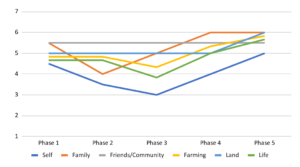
Figure 6. The line chart shows Judi Hetherington’s response to the wellbeing survey responses across the five phases of practice change at Walma (1940 – 2023) (where 1 denotes very unhappy and 7 denotes very happy).
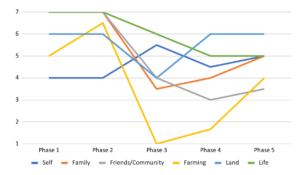
Business outcomes
For decades Rob and his family have invested in soil health and in refining their model of farming in a low rainfall cropping farm using biological inputs and companion and multispecies cropping. In 2023 the Hetheringtons worked with Vanguard Business Services on a five year ‘snapshot’ of their business (2017 – 2022). The analysis presents a range of business characteristics related to income, costs, and variability at the whole farm level.
When looking at the Trading Income and Total Expenses (Figure 7), there is potential for the farm to be very profitable under good seasonal conditions, with total trading income of over $2 million in the 2021/22 good season. The business also performs reasonably during poor seasons, with total expenses only just exceeding trading income during the severe 2019/20 drought. This same figure also illustrates that despite both income and expenses fluctuating with seasonal conditions, expenses are significantly more stable.
Figure 7. Trading Income (Gross Income) and Total Expenses from the five years of study. Source: Vanguard Business Services.
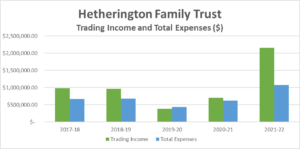
One of the standout aspects of the Hetheringtons’ operation is their use of biological fertilisers (e.g. seed dressings, liquid inject and foliar sprays) in combination with traditional fertilisers and weed control. The chart below (Figure 8) shows the costs for biological fertilisers increasing at a much lower rate than traditional fertilisers on a per hectare basis. This indicates that biological fertilisers were able to partially insulate the Hetheringtons from global price fluctuations such as the substantial inreases in urea and phosphate during 2021 and 2022. Rob also grows multispecies and companion crops, both of which have received premium prices in recent years, and have been grown without the use of synthetic nitrogen fertiliser. One of Rob’s goals with biological fertilisers is to increase the efficacy of traditional inputs, which were shown to have the highest rate of input cost increase. You can read more about Rob’s use of biological fertilisers in the narrative above.
Figure 8. Biological vs traditional fertiliser expenses per hectare. Source: Vanguard Business Services.
Production output and quality
As this case study has shown, for several decades the focus at Walma has been to build soil health, as Rob understands the central priority for the farm and its ongoing productivity. The Business analysis shows that through his work to closely measure soil and plant status he has been able to develop a refined approach to fertility inputs that controls costs whilst maintaining production and improving soil condition.
Recent crop quality results indicate that Rob’s approach is paying off. For example, in 2021 his canola oil content was high enough (51.3%) to secure a premium, receiving a price of $1100/tonne. Rob has never had such high oil content. In Western Australia, the base oil content for payment is 42% (Kingwell 2019). This particular canola crop was grown with a legume companion and received limited additional synthetic nitrogen inputs. Rob also attributes the positive result to his focus on sulfur, which he is ‘spoon feeding into the system’.
The ungraded multispecies crop that Rob has grown over the last two years is highly valued by his dairy customer who has observed a difference in their milk quality and quantity, and cow health. There has been an increase in production, while not compromising butterfat and protein levels, which are often affected with an increase in quantity. The dairy attributes this to the high grain lipid content (i.e. 4.4% compared to 1.4% for 2021). The dairy has also observed an increase in the overall health of their animals when using this feed, one indicator being a lower somatic cell count leading to low levels of mastitis the cows experience. This result has implications for commercial reward.
Rob has a long-standing interest in soil, plant and human health, like many regenerative farmers is curious about the nutrient content of his grains. Nutrient density of food is an important potential outcome of farming in healthy, functional soil. However, the role of regenerative farming practices and the impact that the soil health and farming methods has on the overall nutrition content has not been widely documented or widely engaged within the Australian landscape. Recognising this, Rob has participated in a pilot nutritional study into the nutrient content of wheat, multispecies, and canola/lupin samples at Walma – stay tuned for further information on this pilot study.
Appendices - Soil test results
Appendix C. Walma Soil Foodweb Institute Results
* More detail on Soil Foodweb Institute Australia’s tests here.
Appendix A, B & C: Each row of results has been coloured using a grey scale, where the lightest colour is the lowest number and the darkest colour is the highest number in the row. Colour coding does NOT indicate positive or negative results, and is merely provided to allow simple visual comparison of the numbers in each row.
References
Australian Centre on Quality of Life (2020) Personal Wellbeing Index. Retrieved from <https://www.acqol.com.au/instruments#measures>.
Brown K, Schirmer J and Upton P (2021) ‘Regenerative farming and human wellbeing: Are subjective wellbeing measures useful indicators for sustainable farming systems?’ Environmental and Sustainability Indicators, 11(100132): https://doi.org/10.1016/j.indic.2021.100132
Isbell RF and the National Committee on Soil and Terrain (NCST) (2021) The Australian Soil Classification (Third edit). CSIRO Publishing, Melbourne.
Kingwell, R (2019) ‘Why do one percenters matter so much? How small changes in management that affect prices, quality, yields or production costs can result in large impacts on profit’, Grains Research & Development Corporation, Australia.
Masters N (2019) For the Love of Soil: Strategies to Regenerate our Food Production System, Integrity Soils, USA.
Regional Wellbeing Survey (RWS) (2020) The University of Canberra. Retrieved from <https://www.regionalwellbeing.org.au/project/regional-wellbeing-survey-user-guide/>.
Sawkins, D (2011) Landscapes and soils of the Lake Grace District. Bulletin 4825, Department of Agriculture and Food, Western Australia.
Schirmer J, Yabsley B, Mylek M, and Peel D (2016) ‘Wellbeing, resilience and liveability in regional Australia: The 2015 Regional Wellbeing Survey’, University of Canberra, Canberra.
Full Reports
External Links
Your Questions
Do you have questions or feedback? We’d love to know more about you and your needs around our case study reports, get in touch.
To hear the latest, follow us on social media or subscribe to our newsletter.
This project is supported by the Australian Government’s Smart Farms Program.





